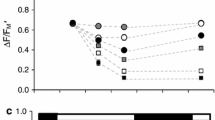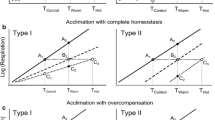Abstract
The hypothesis that species inhabiting warmer regions have greater photosynthetic tolerance of high temperatures was tested using the temperature-dependent increase in fluorescence (T-F o). Congeneric species pairs of Atriplex, Salvia, Encelia, and Eriogonum with desert versus coastal distributions were studied in a common environment and in the field. In addition, 21 species with contrasting microclimate distributions were studied at a field site in a northern California chaparral community. The average July maximum temperature within the current distributions of species was quantified using a geographic information system. Four parameters (T crit, T S20, T 50, and T max) of the T-F o response were used to quantify photosynthetic thermotolerance. In the common environment, only the desert Atriplex species was significantly greater for all T-F o parameters when compared to its coastal congener. In the field, desert species had significantly greater T crit, T S20, T 50, and T max when compared to coastal species. The magnitude of variation between species and between genera was similar in the common environment and the field. However, T crit, T S20, T 50 and T max were all significantly greater when measured in the field. There was no relationship between T-F o parameters and the microclimate distribution of the 21 species at the chaparral field site. In addition, T-F o parameters for all 35 species were not correlated with the average July maximum temperature within the species ranges. However, there was a significant negative correlation between the average annual amount of precipitation inside species' ranges and T S20. Our results show that photosynthetic thermotolerance is (1) significantly different between genera and species, (2) highly plastic, (3) not necessarily greater for species with warm climate distributions when measured in a common environment, but (4) significantly greater overall for desert species compared to coastal species when measured in the field.
Similar content being viewed by others

Author information
Authors and Affiliations
Additional information
Electronic Publication
Rights and permissions
About this article
Cite this article
Knight, C.A., Ackerly, D.D. An ecological and evolutionary analysis of photosynthetic thermotolerance using the temperature-dependent increase in fluorescence. Oecologia 130, 505–514 (2002). https://doi.org/10.1007/s00442-001-0841-0
Received:
Accepted:
Published:
Issue Date:
DOI: https://doi.org/10.1007/s00442-001-0841-0



